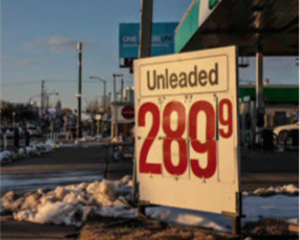Inflation
通貨膨脹
Base jumping
高空跳傘
America's inflation spike begins
美國的通貨膨脹開始飆升
In the spring of 2020 American consumer prices fell for three consecutive months as the pandemic struck. Rents collapsed, hotel rooms went empty and oil prices turned negative. All sudden spurts of deflation or inflation make the news twice: first when they happen and then a year later, when they distort comparisons that look back 12 months. Sure enough on April 13th statisticians announced that consumer prices in March were fully 2.6% higher than a year earlier, up from 1.7% in February. The increase in headline inflation was the biggest since November 2009, when similar "base effects" were in play after the global financial crisis.
2020年春天大流行爆發后,美國的消費者價格指數連續三個月下降。租金暴跌,酒店客房空空如也,油價下跌。所有突然爆發的通貨緊縮或通貨膨脹都會出現兩次新聞:首先是當它們發生的時候,然后是一年后,當他們對過去12個月進行歪曲對比時。果然,4月13日,統計人員宣布三月份的消費者價格指數比去年同期上漲了2.6%,高于二月份的1.7%。這是自2009年11月以來的最大增幅,當時全球金融危機后也出現了類似的“基數效應”。
It would be wrong, however, to dismiss the rise in inflation as a mere mathematical quirk. America's economy is emerging from the downturn at great speed as jobs return and vaccinated consumers start spending. In March alone prices rose by 0.6% compared with the previous month, the fastest pace since 2012. Much of that was driven by a big increase in petrol prices but even the "core" consumer-price index (CPI), which strips out food and energy prices, was up by 0.3% (an annualised pace of 4.1%). Services prices in particular have started to rebound: hotel rooms were 4.4% dearer than a month earlier and rent, a big component of the index, has firmed in recent months. Capital Economics, a consultancy, predicts that the combination of base effects and a boomy reopening will drive the headline annual rate of inflation close to 4% by May.
然而,如果認為通脹上升只是數學上的怪癖,那就大錯特錯了。隨著就業機會的恢復和消費者開始消費,美國經濟正以極快的速度從衰退中復蘇。僅3月份,房價就比上月上漲了0.6%,這是自2012年以來的最快漲幅。這主要是由于汽油價格的大幅上漲,但即使是剔除食品和能源價格的“核心”消費者價格指數(CPI)也上漲了0.3%(折合成年率為4.1%)。特別是服務價格已經開始反彈:酒店客房價格比一個月前上漲了4.4%,而作為該指數重要組成部分的租金在最近幾個月也趨于穩定。咨詢公司凱投宏觀預測,基數效應和繁榮的重新開業將推動5月份的年通貨膨脹率接近4%。

The Federal Reserve targets annual inflation of 2%, but on a different measure— the price index for personal consumption expenditures—which tends to run about a third of a percentage point cooler than CPI. Still, if prices rise at a monthly pace consistent with the Fed's target, as they roughly have in recent months, base effects mean that the target will soon be exceeded in annual terms. Any heat in the economy will lead to further overshooting.
美聯儲的年通脹率目標是2%,但采用的是另一種衡量標準——個人消費支出的價格指數——它往往比CPI低約三分之一。然而,如果物價以與美聯儲目標一致的月度速度上漲,就像近幾個月來的情況一樣,基數效應意味著每年的目標將很快被超越。經濟中的任何過熱都將導致進一步的過熱。
The path of inflation matters more than usual because of the amount of economic uncertainty in the air. The relaxation of social-distancing restrictions, President Joe Biden's enormous $1.9trn economic stimulus and the unusual doveishness of the Fed, which is employing a new monetarypolicy framework, together comprise an inflation experiment. It has turned some doves into hawks, with economists such as Larry Summers, a former treasury secretary, and Olivier Blanchard, a former chief economist of the IMF, warning of the risk of overheating. And, as the administration follows up its stimulus with an infrastructure bill, how the experiment pans out will help determine how much more deficit spending the economy can take.
由于空氣中彌漫著大量的經濟不確定性,通脹的走勢比以往更為重要。放松社交距離限制、美國總統喬·拜登推出1.9萬億美元的巨額經濟刺激計劃,以及美聯儲非同尋常的鴿派態度(美聯儲正在采用新的貨幣政策框架),共同構成了一項通脹實驗。它已經把一些鴿派變成了鷹派,前財政部長拉里·薩默斯和前國際貨幣基金組織首席經濟學家奧利維爾·布蘭查德等經濟學家警告了經濟過熱的風險。而且,隨著奧巴馬政府在刺激計劃之后推出一項基礎設施法案,這項試驗的結果將有助于決定美國經濟還能承受多大的赤字支出。
譯文由可可原創,僅供學習交流使用,未經許可請勿轉載。











